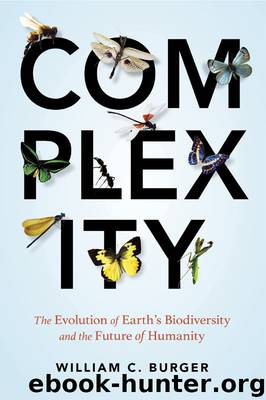Complexity by William C. Burger

Author:William C. Burger
Language: eng
Format: epub
ISBN: 9781633881945
Publisher: Prometheus Books
Published: 2016-05-22T16:00:00+00:00
THE ADVANTAGE OF DOUBLE FERTILIZATION
Does double fertilization, yielding a triploid endosperm with three sets of chromosomes, make much difference? For the developing embryo and seed, probably not. Nevertheless, double fertilization was a key factor in Angiosperm success. To understand the importance of double fertilization, we need to look at that other grand crowd of seed plants, the Gymnosperms. These include pines, cedars, redwoods, and other conifers: cycads, gingkoes, and the strange Gnetopsids. Gymnosperm means naked seed, because the seed is not enclosed within an ovary. Angiosperm means hidden seed, since it forms within the ovary. Before the arrival of flowering plants, Gymnosperms dominated terrestrial landscapes, and they still do in the grand conifer forests of America's Pacific Northwest and Rocky Mountains, Podocarpus forest just beneath the summit of Mt. Kenya, or the vast needle-leaf forests of the northern taiga. But despite a long history, they number less than a thousand living species, and all are woody. This is an important point: there is no such thing as an herbaceous Gymnosperm! In striking contrast, Angiosperms have herbs scattered all across their many lineages, from lilies and grasses to petunias and an awful lot of weeds. What explains the ability of flowering plants to make so many weeds?
Gymnosperms just aren't very clever. Most of them produce seeds and endosperm in advance of fertilization. Not smart! Wind-pollinated Gymnosperms depend on frequent winds and closely grouped populations to effect fertilization; when these parameters are lacking, fertilization may fail. Producing energy-rich seeds that cannot sprout—because they weren't fertilized—is a huge waste of energy.17 Larger woody plants can afford this waste; little plants cannot! To repeat: most Gymnosperms produce energy-rich seeds before fertilization has taken place. That's not the way Angiosperms operate. What double fertilization does is to initiate endosperm production only after fertilization has occurred. Thanks to double fertilization, precious resources will not be wasted on seeds that cannot sprout. In addition, tight coupling of fertilization with endosperm initiation speeds up seed production. This is why flowering plants have been able to produce so many little short-lived herbs and why, after three hundred million years, the Gymnosperms have never built a weed.
Download
This site does not store any files on its server. We only index and link to content provided by other sites. Please contact the content providers to delete copyright contents if any and email us, we'll remove relevant links or contents immediately.
Sapiens: A Brief History of Humankind by Yuval Noah Harari(14322)
The Tidewater Tales by John Barth(12627)
Mastermind: How to Think Like Sherlock Holmes by Maria Konnikova(7281)
Do No Harm Stories of Life, Death and Brain Surgery by Henry Marsh(6908)
The Thirst by Nesbo Jo(6882)
Why We Sleep: Unlocking the Power of Sleep and Dreams by Matthew Walker(6659)
Life 3.0: Being Human in the Age of Artificial Intelligence by Tegmark Max(5520)
Sapiens by Yuval Noah Harari(5325)
The Longevity Diet by Valter Longo(5044)
The Body: A Guide for Occupants by Bill Bryson(5033)
The Rules Do Not Apply by Ariel Levy(4912)
The Immortal Life of Henrietta Lacks by Rebecca Skloot(4552)
Animal Frequency by Melissa Alvarez(4430)
Why We Sleep by Matthew Walker(4395)
The Hacking of the American Mind by Robert H. Lustig(4342)
Yoga Anatomy by Kaminoff Leslie(4335)
All Creatures Great and Small by James Herriot(4277)
Double Down (Diary of a Wimpy Kid Book 11) by Jeff Kinney(4244)
Embedded Programming with Modern C++ Cookbook by Igor Viarheichyk(4144)
